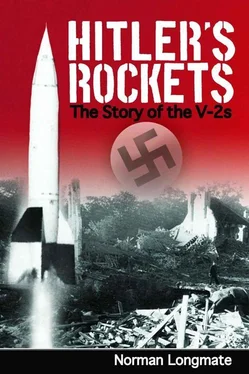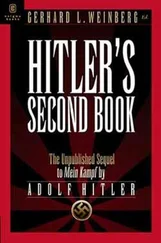We discussed the V-2 rocket during the meal and Churchill got in several humorous digs at Lindemann, who kept on repeating that it was a stupid sort of weapon. The PM said it was becoming a very accurate weapon, and, obviously, he had not forgotten that Lindemann had said that it could not be produced as an effective weapon of war.
In a memo to Churchill a month later, on 5 December, Cherwell reaffirmed his sceptical view of the missile’s future:
Although rockets may play a considerable tactical role as long-range barrage artillery behind the lines at twenty, thirty or even fifty miles, I am very doubtful of their strategic value. It seems likely that it will always be possible to deliver the same quantity of explosive much more economically and accurately from aircraft than from rockets and without anything like the same limitations of range.
To this view Cherwell clung with unshakeable peristence and on 6 April 1945, with the last V-2 already fired, he again wrote to the Prime Minister on the subject, this time comparing the V-2 unfavourably to the flying bomb:
V-2 has the merit against V-1 that it can be fired without any launching site other than a flat bit of road or hard surface a dozen yards square and that it cannot be shot down in flight. There is not much difference in accuracy between the two weapons and as the V-2 costs at least ten times as much as the V-1, it scarcely seems as economic proposition. The comparison with a bomber, of course, is still more unfavourable.
R. V. Jones showed greater prescience. In September 1944 he wrote for the United States Air Force – who were far quicker than the British government to grasp the V-2’s long-term significance – an article attributed only to ‘a British source’:
There can be no doubt that with the A-4 the rocket has come to stay…. Reviewing… reasonable extrapolation from present practice, a two-stage rocket of about 150 tons starting weight could deliver a one-ton warhead to nearly 3,000 miles range, with a probable error of 10 miles in range and three miles in line. This might be a feasible weapon for delivering a uranium bomb, should such a bomb become practicable…. At the moment such a rocket could not be intercepted, but by the time it becomes a serious possibility it may itself be a target for smaller defence rockets fitted with predictors and homing devices…. The long range rocket can be developed much further. In the light of this fact, we must watch.
The legacy of the rocket in the shape of bereavement and grief, serious wounds and minor scars has already been mentioned. Apart from them most evidence of the V-2’s existence has now vanished. All that are left are souvenirs, a source of interest rather than alarm. One wartime schoolboy still has in his garden shed in Tottenham the piece of rocket casing which nearly ended his life forty years ago, when it landed where he had been standing just before the milkman, whom he had been helping before school, pushed him under his cart – ‘one of the last of the push type with two large wheels and a small one in front’. In Kent a wartime fireman still cherishes part of the very last V-2 to fall; at Bramerton, near Norwich, a portion of one of the very first now revolves harmlessly as a weather vane. The most enduring of such relics were the combustion chambers that formerly littered the fields of East Anglia, one of which was described by a Suffolk newspaper in February 1984. ‘Rabbits had used it as a burrow and pheasants had nested in it’, before a local farmer moved it to his home and ‘planted flowers in it to brighten up his drive’; it is now in the local aviation museum, near Bungay. The V-2, so feared in its day, is now everywhere a museum piece. One can be seen in the Imperial War Museum and another, with its casing cut away to show the fantastically complicated network of pipes inside, in the Science Museum in South Kensington. Elsewhere it survives only in the memory of people now well on into middle age. In The Hague older residents may still point out open spaces which mark the spot where a misfired rocket plunged back to earth, while a few people in Hackney can even now identify the spot on the famous Marshes where a rocket landed, creating a crater that was, most fittingly, used as the site for a huge bonfire on VE night.
Information about the V-2s is surprisingly hard to come by. Churchill’s hint in April 1945 that telling their story had a low priority proved amply justified. In his own war memoirs they are mentioned very cursorily, in the official war histories they receive far less space than the conventional raids or the flying-bombs, and in Air Chief Marshal Hill’s official report on the secret-weapon campaign, published in October 1948, they are given only 10 paragraphs out of 247, although Hill himself admits that the rocket ‘was in some ways a more disturbing menace than the flying-bomb’. Local authorities which wished to publish full details of V-2 incidents in their war histories, even after the war was over, were forbidden to do so, and many local libraries and record offices lack even the scantiest information about local incidents, while possessing a mass of documents on earlier events. It is as though the whole subject, where British scientists fell so far behind their German rivals, and British ministers and commanders proved totally unable to protect their citizens, was too painful and embarrassing to be properly documented. Only with the release of the files in the Public Record Office has it become possible to study the V-2’s effects comprehensively, and even here there are tantalizing…. gaps.
The Germans have felt no such inhibitions as their former enemies. A mass of records about the development of the V-2 have survived and been used by previous writers, and von Braun himself, in collaboration with an American writer, published a massive History of Rocketry and Space Travel in 1966, which, very typically, takes for granted that, having invented it, the Germans were right to try out the missile in action. There is no hint of guilt in the authors’ comment that the missiles ‘were responsible for more than 2,500 deaths and great property damage’, and they make clear that the offensive was abandoned only when it appeared that the V-2 ‘clearly was going to neither influence the war’s outcome nor delay its end’. Dornberger, in his time an honourable soldier, raises the moral implications of using such an innately indiscriminate weapon only to dismiss them:
The operational use of the A-4 at an imperfect state of development will… be called pointless, brutal and inhuman, but, if so, all long-range artillery and bombing must accept the same condemnation. The dispersion of the V-2 in relation to its range was always less than that of bombs and big guns.
His only regret was that he had not been able to make more, and better, rockets sooner and thereby enable Hitler to defeat and enslave his most persistent enemy:
We were well aware that operational employment of the A-4 in the autumn of 1944 could not of itself win the war. But what might have happened if from two years earlier, say summer 1942, for years on end, by day and night, more and more long-range rockets with everincreasing range, accuracy and effect had fallen on England?… The use of the V-2 may be aptly summed up in the two words: ‘too late’. Lack of foresight in high places and failure to understand the technical background were to blame.
But was the V-2 even in its relatively primitive stage of development so unsatisfactory a weapon? On this there seems to be a curious unanimity between those who have studied the subject in both countries. Lord Cherwell, for example, in his note of 6 April 1945 already quoted, made the point that ‘a Mosquito, which is comparable in price with one or at most two V-2s, can drop about 250 tons of bombs in its life, with at least a hundred times greater accuracy, on any target within 600 miles’. David Irving, author of the standard (and excellent) account of the rocket’s development, who is certainly no uncritical admirer of Cherwell – his book’s very title, The Mare’s Nest , immortalizes Cherwell’s most notorious error of…. judgement – also thinks the argument of price decisive. ‘No A-4 rocket’, he comments, truthfully enough, ‘could… have cost much less than £12,000 by the time it was delivered to the launching troops; this was certainly not the cheapest way of delivering 1,620 pounds of conventional explosive… to a maximum range of 200 miles.’ Albert Speer, no mean authority on munitions manufacture, was equally sceptical, looking back twenty-five years later, of the rocket’s economic viability:
Читать дальше






![Traudl Junge - Hitler's Last Secretary - A Firsthand Account of Life with Hitler [aka Until the Final Hour]](/books/416681/traudl-junge-hitler-s-last-secretary-a-firsthand-thumb.webp)





